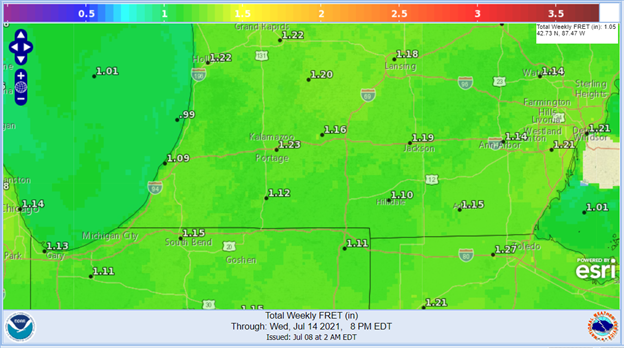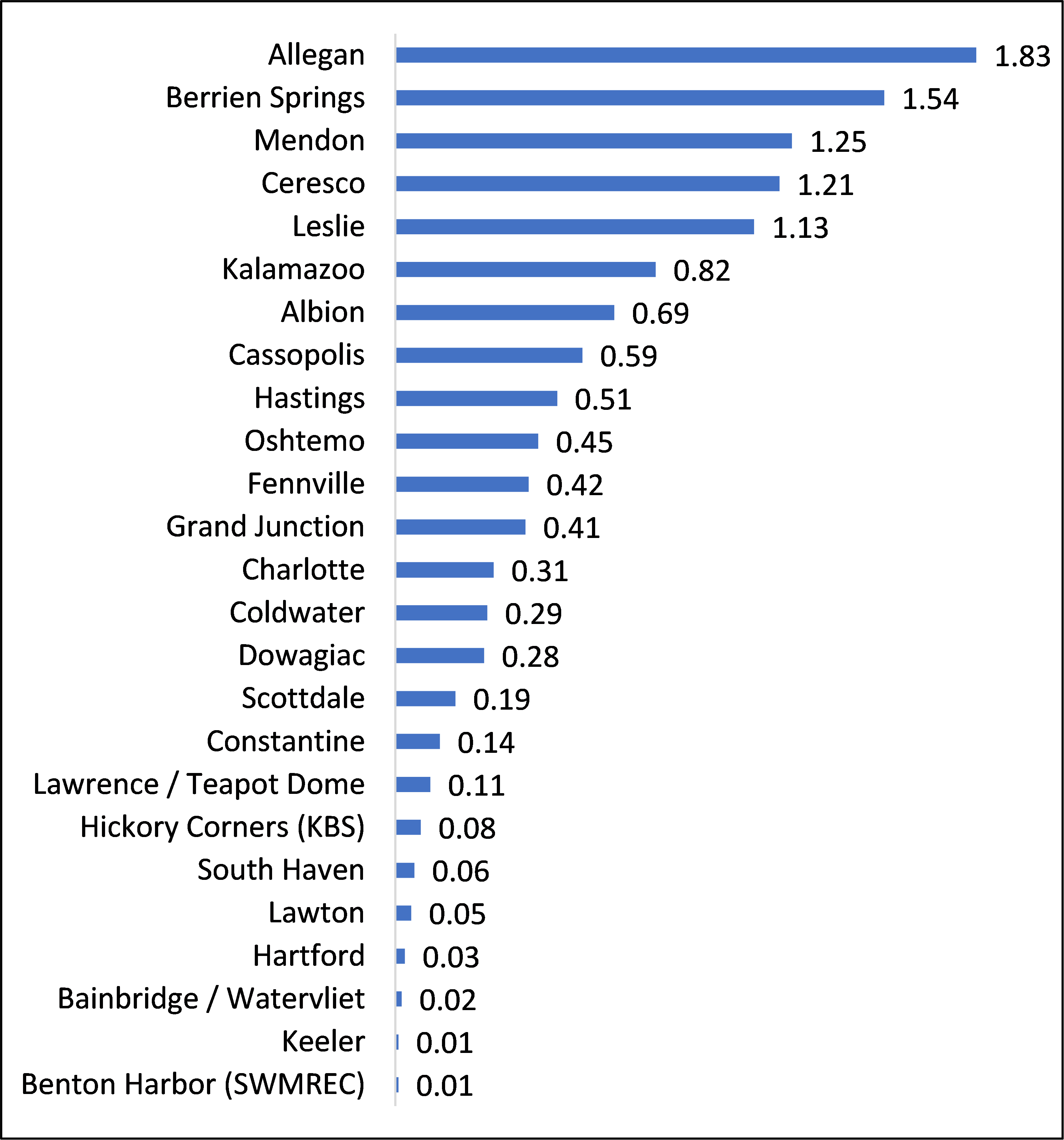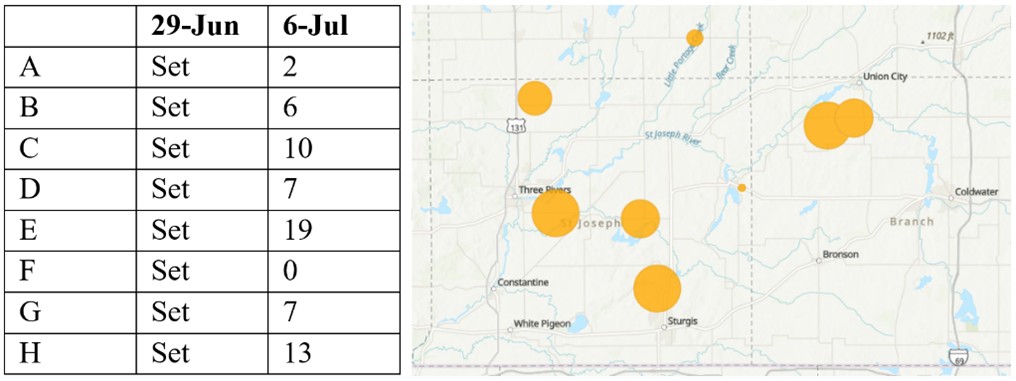Southwest Michigan field crops update – July 8, 2021
Warm weather and adequate moisture pave the way for good crop growth as we head into reproductive stages in corn and soybean.

Weather
Temperatures this past week were a few degrees above normal as the warm air mass from western Canada rolled into Michigan last weekend. Temperatures will be cooler than normal during the end of this week but will moderate to normal by the beginning of next week. Weekly forecasted reference evapotranspiration rates (FRET) will be a bit below normal this coming week with daily rates around 0.16 inches. The medium-range outlooks call for above-normal temps during the middle of July.
Precipitation this past week has been near normal overall with an average of 0.5 inches received at Michigan State University Enviroweather stations in the region. However, localized thundershowers deposited as much as 2 inches of rain in a short period on Wednesday. As predicted, precipitation in the past three weeks has brought plant-extractable soil moisture in the top 3 feet up to near-normal levels in the region after having been in a significant deficit for most of the early growing season.
Also, as predicted, southern Michigan is no longer under any level of drought according to the U.S. Drought Monitor released July 8. The next good chance of rain comes overnight Friday and into the weekend and continuing for most of next week with predicted totals of 1-2 inches for the week. The medium-range outlooks call for wetter than normal conditions for the middle of the month.





Crop update
Wheat harvest has begun in the region with reports of good yields thus far.
Corn in the region is mostly in late vegetative stages (V12-V16) and many seed corn fields have reached the tassel stage (VT). Early-planted soybean has reached full flower (R2) while most fields are starting R1. Corn will be at peak water use from V16 through beginning dent stage while soybean’s peak water use begins at R3 (beginning pod) and goes through full seed (R6)—both crops in these advanced stages will use 1.2 times the grass reference crop. Crops in most earlier planted fields will require 1.25-1.4 inches this coming week. Both crops continue to look very healthy aside from portions of fields that were flooded earlier this summer.
The recent break from the rains has allowed for some field trafficability in many fields. Growers have been using this opportunity to apply late side-dress applications of nitrogen (N) on fields. As is often the case, the earlier planted corn was able to withstand the flooded conditions that we had during later June a bit better, and as long as the plants did not drown out in the flooded areas, they seem to have recovered a bit better. A more daunting challenge will be to decide if it is worthwhile to apply more N to fields. With the repeated rainfall events, we are likely to have lost N from both sandy ground (non-flood damaged fields, for the most part) from leaching and the fields that did get damaged (from flooding on heavier soils) from de-nitrification.
During the first session of the Irrigation Webinar Series on July 7, Purdue University soil fertility specialist Jim Camberato talked about both of these N loss challenges. He suggested that fields that had significant leaching losses of N were usually able to recover quite nicely if additional N was applied to the field as soon as was practical, but even later season applications often showed a yield response in their work in Indiana. He said most forms of N convert to nitrate relatively quickly in warm, moist soils and that nitrate can move with the wetting fronts during repeated heavy rainfall events. He also said that oftentimes fields that have been subject to de-nitrification losses also have some degree of flooding injury to the roots and may be more limited in their ability to utilize additional N. Some fields may also benefit from the addition of additional sulfur as well.
Given the amount of rainfall that occurred in later June, there can be little doubt that some of the N applied moved down below the root zone in heavy rainfall areas. How much N was likely to be lost to the plant may depend upon how much was taken up prior to the rainfall events, how large the plants were, the total rainfall received in any given field, and how much standing water there was that reduced plant health. If you are in an area that received really heavy rainfall, you should be monitoring fields and considering ways of applying more N if the corn stand and color look good. In non-irrigated fields, dribbling on 28% UAN with a highboy applicator may be an attractive option if the corn height will allow trafficability. Fertigation (applying fertilizer through irrigation) would be an excellent option.
Be sure to look at the MSU Extension Irrigation Resources website for more information on how to apply N through irrigation and the equipment needed to do it while protecting the water source from contamination.
Disease update
MSU Extension field crops pathologist Marty Chilvers says the risk of white mold in soybean is moderate to high in Michigan currently according to the Sporecaster app with the high rainfall amounts of late and the continued high humidity. Those using the free app can enter row spacing, use of irrigation, extent of row closure, and presence of flowers when entering field data to get an estimate of risk level. Protecting flowers during R1 (one open flower on any node on the main stem) and R2 (open flower at one of the two uppermost nodes on the main stem with a fully developed leaf) is important for fields with a history of white mold, particularly when planted in narrow rows, at high populations, or under irrigation.
Tar spot has been identified in corn in several counties in Michigan this year including St. Joseph, Van Buren, Eaton and Allegan. If we do return to wetter conditions, early- to mid-July is a critical period for the initial infection of tar spot. Extended periods of leaf wetness can help those initial lesions gain a foothold on plants from spores released from the residue. Begin scouting for early lesions, particularly in fields with a history of the disease. Dark, raised lesions will begin low in the canopy if the inoculum is coming from past crop residue. Be aware that bug droppings can also be mistaken for the lesions. As the season progresses and outbreaks occur, inoculum spread by wind will begin infecting the upper canopy.
Fungicide applications are the most effective if they are made when there are only a few lesions per plant. Current recommendations are to make fungicide applications between VT and R2 (possibly later) for the most effective tar spot control.
Insect update
Aside from minor bean leaf beetle feeding in soybean and parties of Japanese beetles in corn whorls, no insect activity has been identified recently. Western bean cutworm moths have begun flying with reports of moth catches in pheromone traps throughout Michigan. Trap counts from Purdue as of June 30 were all single-digit with mostly 0’s, so the counts reported in our region are assumedly from flights occurring in the first week of July. MSU Extension field crops entomologist Chris DiFonzo expects peak flight to occur within the next three weeks. As females look for pre-tassel corn to lay eggs, it will be important to monitor activity as more fields reach the tassel stage (VT).

Weed update
We have seen rapid growth, in both crops and weeds, and many growers have been caught in the scramble to try to control rapidly growing weeds in their fields. The good news is that the weeds have been relatively “soft” following the rain, so control has been better than would normally be expected on larger weeds. Almost all but the latest planted beans are reaching the R1 stage, so the glyphosate application window is drawing to a close for most fields. Overall, the later herbicide applications seem to have been reasonably effective.



 Print
Print Email
Email




